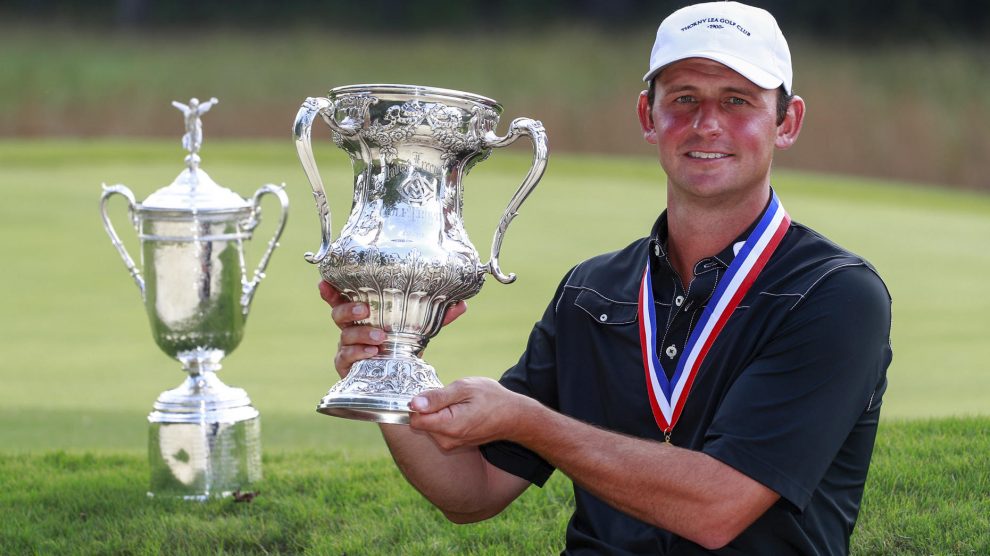In the tradition of Francis Ouimet, Chick Evans, Bobby Jones, Frank Stranahan and many other great American amateur golfers, the Amateur Golf Alliance wants to further amateur golf in this country, as well internationally.
The Amateur Golf Alliance (AGA) was founded in 2014 after the first Concession Cup was held at the Concession Club in Florida. The Concession Cup was founded as a biennial competition featuring a team of Mid-Amateur and senior golfers from Great Britain & Ireland (GB&I) taking on a team from the United States. Every participant enjoyed the competitive matches and camaraderie from that initial event, and from the decision was born to create the AGA to continue the Concession Cup and use it as a way of enhancing amateur golf.
The Concession Cup is named for one of the greatest acts of sportsmanship ever witnessed. Jack Nicklaus conceded a 3-foot putt to Tony Jacklin on the final hole of the 1969 Ryder Cup at Royal Birkdale, allowing the matches to end in a 16-16 tie. Team USA retained the cup, but that was the first time the matches had ended in a draw.
Jacklin, who had won the Open Championship earlier that year, would have been crucified by the British media if he had missed the putt and caused GB&I to lose the match entirely.
Nicklaus said at the time, "I don't think you (Jacklin) would have missed it, but I wasn't going to give you the chance, either.”
It is in that spirit of sportsmanship that the Amateur Golf Alliance promotes and enhances amateur golf.
The AGA is an independent organization, which depends solely on donations from individuals to operate. They have identified several areas in the game that need attention and are working to fill those gaps.
One such area is the lack of one association in the United States responsible to provide financial assistance to exceptional young golfers. The USGA conducts tournaments, keeps handicaps and administers the Rules of Golf in the US and Mexico, but no organization is responsible for establishing a national golf program. Other countries have a national golf program that identifies talented players at an early age and provides the assistance necessary to foster their growth in the game. One of the main tenets of the AGA is to provide talented amateur golfers with opportunities to gain experience through competition domestically and abroad.
In the United States, local junior golf programs and the American Junior Golf Association (AJGA) provide a series of tournaments. Some financial assistance is available for up-and-coming players, such as the AJGA’s ACE Grant, but talented young golfers worthy of a college scholarship, or even the next Tiger Woods, could be falling through the cracks and unable to pursue their dreams due to a lack of funding. These are the young people that the AGA has targeted to help in its effort to promote amateur golf and they have already registered two success stories.
Chandler Phillips, a member of the Texas A&M golf team, was ranked sixth in the nation by Golfweek. He had won two collegiate events with a 69.5 stroke average. Chandler’s goal was to qualify for the Palmer Cup team since selection was based solely on collegiate events and Texas A&M could cover his expenses. A spot on the Palmer Cup team would bolster his ultimate goal of earning a berth on the Walker Cup team.
Both of his parents work and his brother is autistic, which puts an additional strain on the family budget. Extra funds were not available for Chandler to travel to non-collegiate sponsored amateur tournaments to qualify for a spot on the Walker Cup Team.
The AGA was made aware of his situation and following all NCAA and USGA regulations provided the funds necessary for Chandler to compete. He finished tied for sixth in the Northeast Amateur, plus garnered a fourth-place finish in the Trans-Miss Amateur. He did not earn a spot on the 2017 Walker Cup team, but was able to chase his dream with the help of AGA.
The second player that has received financial assistance from the AGA, Matt Parziale, won the U.S. Mid-Amateur Championship and earned spots in the 2018 Masters, U.S. Open at Shinnecock and the U.S. Amateur at Pebble Beach.
After a successful collegiate career, Parziale tried professional golf but decided to follow in his father’s footsteps and became a fireman in his hometown of Brockton, Mass. Matt regained his amateur status and continued to play in local amateur competitions, but aspirations of competing in larger national amateur tournaments did not fit his budget. The AGA was made aware of Parziale’s talent and helped him enter several national events, which allowed him to prepare to compete in USGA events.
Parziale told us, “I could never have been able to compete at the level I achieved at the U.S. Mid-Am Championship without the help of the Amateur Golf Alliance.”
The funding made it possible for him to compete in two events in Florida over the winter. When the snow melted in Massachusetts, he won the Massachusetts Amateur Championship as well the Francis Ouimet Memorial Tournament, before adding a USGA Championship to his 2017 accomplishments.
In addition to supporting talented amateur golfers, the AGA is involved with creating future amateur tournaments, plus providing additional funding for research and other organizational initiatives to benefit amateur golf.
“Our hope is that the Amateur Golf Alliance can foster the development of amateur golf worldwide," AGA President Alan Fadel said. "Through research, creation of competitive golf tournaments and funding talented golfers, the amateur game will continue to grow and prosper, in both the United States and internationally.”
This story was first published in Ohio Golf Journal. To subscribe and for more information, visit their website.

